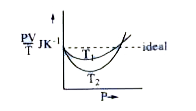(A): Different gases at the same conditions of temperature and pressure have different root mean square velocities.
(R ):Average kinetic energy of gas is directly proportional to absolute temperature.Solution in Telugu
Both (A) and ( R) are true and (R ) is the correct explanation of (A)
Both (A) and (R ) are true and (R ) is not the correct explanation of (A)
(A) is true but (R ) is false
Both (A) and (R ) are false
The correct Answer is:B
Step by step video, text & image solution for (A): Different gases at the same conditions of temperature and pressure have different root mean square velocities. (R ):Average kinetic energy of gas is directly proportional to absolute temperature. by Physics experts to help you in doubts & scoring excellent marks in Class 11 exams.
Updated on:21/07/2023Topper's Solved these Questions
- KINETIC THEORY OF GASESBOOK - AAKASH SERIESCHAPTER - KINETIC THEORY OF GASESEXERCISE - EXERCISE-2(Kinetic Theory of an ideal gas)
25 Videos
- KINETIC THEORY OF GASESBOOK - AAKASH SERIESCHAPTER - KINETIC THEORY OF GASESEXERCISE - EXERCISE-3(Kinetic Theory of an ideal gas)
4 Videos
- KINETIC THEORY OF GASESBOOK - AAKASH SERIESCHAPTER - KINETIC THEORY OF GASESEXERCISE - EXERCISE-IA(Degree of Freedom)
35 Videos
- KINEMATICSBOOK - AAKASH SERIESCHAPTER - KINEMATICSEXERCISE - ADDITIONAL PRACTICE EXERCISE (PRACTICE SHEET (ADVANCED)) (Integer Type Questions)
12 Videos
- LAWS OF MOTIONBOOK - AAKASH SERIESCHAPTER - LAWS OF MOTIONEXERCISE - PRACTICE EXERCISE
108 Videos
Similar Questions
cylinder of capacity 20 litres is filled with H2 gas. The total average kinetic energy of translatory motion of its molecules is 1.5×105 J. The pressure of hydrogen in the cylinder is
View SolutionGiven is the graph between PV/T and P for 1 gm of oxygen gas at two different temperature T1 and T2 (Given:Density of oxygen=1.429kg/m3).The value of PV/T at the point A and the relation between T1 and T2 and respectively

View SolutionA cylinder rolls without slipping down an inclined plane, the number of degrees of freedom it has, is
View SolutionThree particles start from origin at the same time: one with velocity v1 along positive x - axis, the second along the positive y-axis with a velocity v2 and the third along the line y=x with such a speed that all the three always stay in a straight line, then the velocity of the third particle is √kV1V2(V1+V2).
View SolutionA force of 50 N acts on a body of mass 10 kg at rest. Its velocity after 5 seconds if the same force acts, is
View SolutionAssertion : Different gases at the same conditions of temperature and pressure have same root mean square speed
Reason : Average K.E. of a gas is directly proportional to temperature in kelvin
View SolutionAssertion. Different gases at the same conditions of temperature and pressure have same root mean velocity. Reason. Root mean square velocity lies between average velocity and most probable velocity.
View SolutionShow that R.M.S. velocity of gas molecules is directly proportional to square root of its absolute temperature.
View SolutionAccording to kinetic theory of gases the root mean square velocity is directly proportional to
View SolutionShow that the average kinetic energy of a gas moJecrule is directly proportional to the temperature of the gas.
View Solutionदो विभिन्न गैसों के ताप समान है | क्या उनके अणुओ के वर्ग माध्य मूल वेग समान होंगे ?
View SolutionStatement I: The root mean square speeds of the molecules of different ideal gases at the same temperature are the same.
Statement II: The average translational kinetic energy of molecules of different ideal gas are same at the same temperature.
View SolutionUse kinetic theory of gases to show that the average kinetic energy of a molecule of an ideal gas is directly proportional to the absolute temperature of the gas.
View SolutionProve that the average kinetic energy of a molecule of an ideal gas is directly proportional to the absolute temperature of the gas.
View SolutionRoot mean square velocity of a gas is directly proportional to the absolute temperature of the gas.
View Solution
